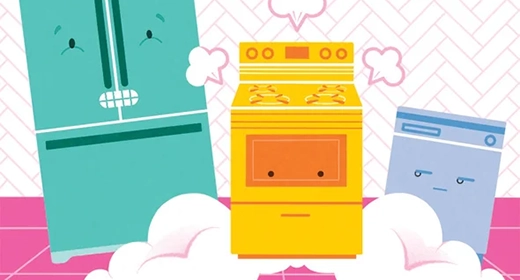by Claudia Wallis: Evidence is building that fumes from gas stoves can aggravate lung ailments.
 Editor’s Note (1/17/22): A member of the U.S. Consumer Product Safety Commission triggered an uproar last week by saying that gas stoves were a hazard and that the agency was considering regulating or banning them. To clarify the risks, Scientific American is republishing this recent article from the November 2022 issue, which reports on studies about indoor air pollution linked to gas stoves and how such pollution can worsen respiratory illnesses. The safety commission has recently announced it is only planning to collect public comments on the stoves and is not considering a ban.
Editor’s Note (1/17/22): A member of the U.S. Consumer Product Safety Commission triggered an uproar last week by saying that gas stoves were a hazard and that the agency was considering regulating or banning them. To clarify the risks, Scientific American is republishing this recent article from the November 2022 issue, which reports on studies about indoor air pollution linked to gas stoves and how such pollution can worsen respiratory illnesses. The safety commission has recently announced it is only planning to collect public comments on the stoves and is not considering a ban.
I love my gas stove. There’s nothing quite like cooking over that beautiful blue flame, so quickly adjusted with a flick of a dial and so suited to its purpose that when things are going well in life, we say we are “cooking with gas.” But in recent years environmentalists have been warning that gas stoves are bad for the climate and not so great for our health, either. Two new studies out this year have heightened health worries about noxious fumes in our kitchens. Is the evidence sufficient to alter our cooking habits? For me, the answer is yes—in some modest ways; others will want to judge for themselves.
Broadly speaking, there are two categories of concerning emissions related to gas stoves. First, there is the unburned natural gas that can escape before the flame ignites or leak from a gas hook-up. This gas is more than 90 percent methane. Second, there are the pollutants created by combustion when a burner is on, most notably nitrogen oxides, which can irritate the lungs.
The big surprise in one new study, conducted by environmental scientists at Stanford University, was the amount of unburned gas that leaks into kitchens when a stove is off. They found that more than three quarters of methane that escapes from a stove does so when it is not in use, most likely through imperfect pipe fittings. Only one out of 53 stoves measured for the study—and many more the team has measured since—did not leak when turned off, says Rob Jackson, senior author of the study. Methane is not toxic, but it is a potent greenhouse gas. With 40 million gas stoves across the country, Jackson and his co-authors estimate that the heat-trapping potential of the methane they discharge annually is roughly equivalent to the carbon dioxide released by half a million gas-powered cars.
The Stanford study also looked at the amount of nitrogen oxides produced when using the stoves. In a matter of minutes, families who do not use their exhaust hoods and who have small, poorly ventilated kitchens can surpass the Environmental Protection Agency’s outdoor exposure limit for nitrogen dioxide of 100 parts per billion (ppb) per hour. (The EPA does not have an indoor safety standard for these gases.) Even short exposures to excess nitrogen dioxide can aggravate symptoms in people with respiratory conditions. And there is substantial evidence that long-term exposure raises the risk of developing asthma.
The second study, conducted in the Greater Boston area, looked at the nonmethane components of unburned gas from stoves. They found trace quantities of 21 chemicals considered hazardous by the EPA, including benzene and other volatile organic compounds (VOCs). The amounts were small, but this understudied issue warrants more attention, says lead author Drew Michanowicz, a senior scientist at PSE Healthy Energy, a nonprofit research and policy group. “A lot of us work at home now. We take about 20,000 breaths a day, and my stove is like 10 feet away from me. What else is in natural gas?” Michanowicz also worries that as more people weatherize their homes and seal windows, “you are reducing air exchange, which means indoor pollution will be magnified.”
Not surprisingly, the American Gas Association, an industry group, has criticized both studies. The levels of VOCs found in the Boston study are “reassuringly low,” says Richard Meyers, a vice president of the association, noting that the authors “identified no health concern.” As for the Stanford study, Meyers says the nitrogen oxides were measured improperly, using plastic sheets to create small spaces around the stoves. Stanford’s Jackson replies that the tenting was done only in large kitchens to aid in measuring the rate of gas release, and the team’s health risk assessments were based on measurements in open, untented kitchens.
What is the average home cook to make of all this? They might take a cue from Michanowicz, who bought a plug-in countertop induction burner and does much of his cooking on that $100 item. Jackson, for his part, is putting his money where his research is: “I’m replacing a perfectly good gas stove” with an induction stove. He would like governments to provide incentives for people to switch to electric ranges. Several U.S. cities are curtailing the use of natural gas (for stoves and heat) in new construction.
As for me, I’m making some changes. I’ve switched to an electric kettle for boiling water, and despite its annoying noise, I now use the exhaust hood over my stove—something only about 25 to 40 percent of people say they do. And weather permitting, I’ll open a window.




















































